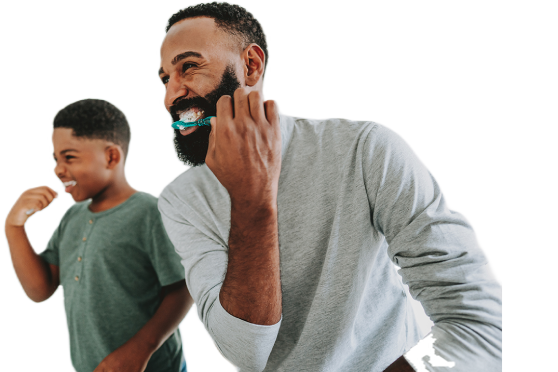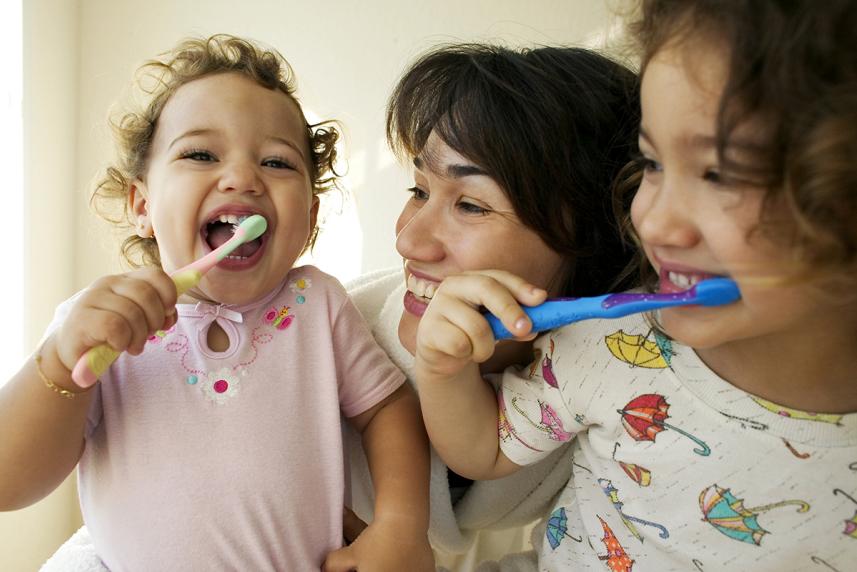
Your Premier Access plan makes it easy. No travel. No scheduling hassles. No additional cost to you! Click below to find your school and sign up.*
*You’ll be directed to MySchoolDentist to complete a permission form.
Tips from dental pros who are parents too

If you’ve ever had cavities, you know why it’s best to avoid them. They can be painful. And they can lead to other problems, such as infection and even tooth loss.
Cavities can start as early as age 1. In fact, 23% of children ages 2 to 5 have cavities in their baby teeth. And by age 8, more than half of children have had at least one cavity.
Helping children develop good brushing habits early is an important way for them to avoid cavities. But sometimes it’s easier said than done. For some families, getting a child to brush their teeth can be a real struggle.
Here are four common brushing battles, and tips for how to get to the other side.
Hearing kids announce that they’ll do something “later” is pretty common for most parents. And kids probably mean it when they say they’ll brush their teeth later. But it often doesn’t happen without an argument.
What you can do: Make brushing part of a routine. Have your child brush at the same time, twice each day. This way, it will be more likely to become a natural habit, says Ricardo A. Perez, D.D.S. Dr. Perez is a parent and a pediatric dentist based in Chevy Chase, Maryland.

Your Premier Access plan makes it easy. No travel. No scheduling hassles. No additional cost to you! Click below to find your school and sign up.*
*You’ll be directed to MySchoolDentist to complete a permission form.
Your child may not like the toothpaste you bought. Or they may not like their toothbrush. But really, your child just wants some control. And this is one area where you can let them in on the decision-making.
What you can do: Let your child pick out the items they need for brushing their teeth. Set a budget and give them a chance to explore their toothbrush and toothpaste options.
Maybe your child thinks their toothbrush is boring. Or maybe the handle doesn’t feel right when they hold it. No matter the reason, if your child isn’t a fan of their toothbrush, you might not get very far trying to make brushing a habit.
You can have your child pick out a toothbrush. “That makes them feel independent,” says Gila Dorostkar, D.D.S. Dr. Dorostkar is a parent and a pediatric dentist based in Mill Valley, California. She is also a member of the American Academy of Pediatric Dentistry’s board of trustees.
“They’re more likely to use things that they got to choose,” says Dr. Dorostkar. She adds that character toothbrushes are popular. They can make toothbrushing more fun, especially for younger kids.
Minty. Fruity. Pasty. Gel. Kids can be picky about toothpaste flavor and texture. And if you buy the “wrong” one, you might have a battle on your hands.
Let your child choose their toothpaste. You may need to try a few to find the right one. “That’s why they make those special flavors for kids’ toothpaste,” Dr. Dorostkar says. For example, many kids don’t like mint. They often say it tastes “hot or spicy,” she says.
The American Academy of Pediatrics recommends using fluoride toothpaste. Known to stop or slow cavities from forming, fluoride is a natural mineral that is in most toothpastes.
Dr. Dorostkar suggests limiting the amount of toothpaste based on your child’s age. “You want just a little smear, a rice-sized kernel, up to age 3,” she says. As the child’s teeth get bigger, the amount of toothpaste you use can grow. The American Academy of Pediatric Dentistry recommends increasing to a pea-sized amount of toothpaste for kids ages 3 to 6.
Dr. Dorostkar says she always recommends fluoride toothpaste. “It is safe,” she says. “It’s effective and it makes such a difference in the tooth decay rate.”
Discover some of the tastiest ways to prevent cavities in kids here.
The American Dental Association recommends two minutes of brushing at a time, from age 3 through adulthood. And if you don’t quite get to two minutes when your child is younger, you’ll want to make sure it’s happening once a child is 9 or 10 years old. At that point, they have many of their adult teeth.
But for a kid, two minutes can feel like, well, forever.
What you can do: Looking at a clock is not going to cut it. There are other, more interesting ways to keep track of the time.
“The electric toothbrush can help kids slow down to spend the full two minutes,” Dr. Dorostkar adds.
Fair enough: Brushing your teeth is not the most exciting task in the world. Since it’s a true must-do, it helps to have a few tricks up your sleeve to make it a more interesting part of your child’s day.
What you can do: Finding ways to get your child more engaged in brushing their teeth can really help turn the experience around — for both of you. If you need ideas, try one of these approaches:
Playing music or singing can make brushing time more engaging, especially for younger kids. Make up your own song or find one online. “There are some YouTube videos that I have found very motivating,” says Dr. Dorostkar. One of her favorites is Sesame Street’s “Brushy Brush!” song.
“Dental apps can be really nice for all age groups to keep them motivated, entertained, and inspired,” Dorostkar says. Ask your dentist, hygienist, or friends for recommendations.
An older child may enjoy brushing their teeth along with you, Perez says. You can track the two minutes together.
Consider taking turns with young children, Dr. Dorostkar says. It’s fun for them to brush your teeth first. That may also make them more open to having you brush theirs. “And keep in mind, children need help with brushing until about age 8, because they don’t have enough control to do it by themselves,” she adds.
Sources: